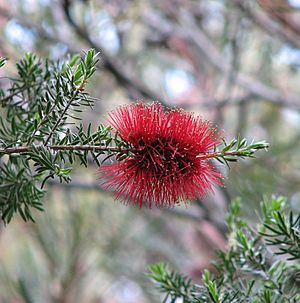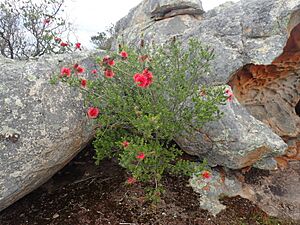Scarlet kunzea facts for kids
Quick facts for kids Scarlet kunzea |
|
|---|---|
 |
|
| Kunzea baxteri | |
| Scientific classification | |
| Genus: |
Kunzea
|
| Species: |
baxteri
|
| Synonyms | |
|
Pentagonaster baxteri Klotzsch |
|
The scarlet kunzea (scientific name: Kunzea baxteri) is a beautiful flowering plant from the myrtle family, called Myrtaceae. It grows naturally only in the south-west part of Western Australia. You can often find it near rocky areas like granite outcrops and hills. This plant is a shrub that grows large, bright red flowers that look like bottlebrushes. Because of its striking look, many people love to grow it in their gardens.

Contents
What Does Scarlet Kunzea Look Like?
The scarlet kunzea is a spreading shrub that usually grows to be about 1 and 3 m (3 and 10 ft) tall. Its branches can be a bit hairy.
Leaves and Flowers
The leaves grow one after another on a small stalk, about 1–2 mm (0.04–0.08 in) long. Each leaf is usually 14–18 mm (0.6–0.7 in) long and 2.5–3.5 mm (0.098–0.14 in) wide. They are shaped like an oval or a long ellipse, and they have tiny hairs along their edges.
The flowers are the most amazing part! They grow in big, showy clusters that look like bright red bottlebrushes. These clusters can be up to 10 cm (4 in) long and 6 cm (2 in) wide. Each cluster usually has between 16 and 30 flowers. What's cool is that the branches keep growing even while the flowers are blooming!
Each flower has five deep red petals that are about 3.5–5 mm (0.1–0.2 in) long. But the most noticeable part is the many bright red stamens. There are between 40 and 50 of these long, thin parts on each flower, and they are four or five times longer than the petals!
When Does it Flower?
Scarlet kunzea flowers most often from July to September. However, if there's enough rain, it can keep flowering as late as March.
Fruit and Seeds
After the flowers, the plant produces a cup-shaped fruit called a capsule. This fruit is about 8–10 mm (0.3–0.4 in) long. Unlike many other plants in the myrtle family, the scarlet kunzea's fruit releases its seeds when it's ready.
How to Tell it Apart
You can tell scarlet kunzea apart from other plants by its bright red flowers, the sepals (small leaf-like parts under the petals) that stay on the fruit, and how its fruit releases seeds. Its oblong leaves and narrow sepals also help tell it apart from a similar plant called Kunzea pulchella, which also has red flowers.
History and Name of Scarlet Kunzea
The scarlet kunzea was first officially described in 1836 by a scientist named Johann Friedrich Klotzsch. He first called it Pentagonaster baxteri. Later, in 1844, another scientist, Johannes Conrad Schauer, changed its name to Kunzea baxteri.
The second part of its name, baxteri, is a tribute to William Baxter. He was an English gardener who collected seeds and plants for nurseries in Britain.
Where Does Scarlet Kunzea Grow?
The scarlet kunzea grows in sandy soil or a type of reddish soil called laterite. It often grows near granite rocks in areas with heath (low shrubs), scrub, or woodlands. You can find it from the coast up to about 100 km (60 mi) inland in different parts of Western Australia.
How Scarlet Kunzea Helps Nature
The scarlet kunzea's large red flowers are very attractive to honeyeater birds and small mammals. These animals help pollinate the plant, which means they help the plant make seeds so new plants can grow.
Growing Scarlet Kunzea in Gardens
People have been growing scarlet kunzea in gardens for many years because of its beautiful flowers. It grows best in places that have dry summers and wet winters. However, it can also adapt to areas with more humidity or places that get some frost. It needs a sunny or partly shaded spot with soil that drains water well. Gardeners have even grown it from cuttings by joining it to the roots of another plant called Kunzea ambigua.

